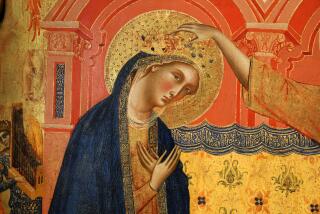Culture : A Roman Orgy of the Senses : The piazza is more than an urban design. It is a noisy carnival where Italian citizens and sensibilities collide.
- Share via
ROME — On a winter’s morning of bright sunshine, everything moves in the Piazza Venezia. And nothing does.
The piazza is the heart of Rome. Histrionic yet cryptic, a metaphor for the Eternal City.
Renaissance popes lived here. From a piazza balcony, Mussolini hectored crowds into a tragic fling with fascism. At the head of the piazza, 19th-Century Romans built a huge white marble wedding cake memorial to King Victor Emmanuel II, first ruler of a modern, united Italy.
Modern Romans despise the overdone memorial, but the young people waving sea-blue flags at its base hardly see it. They have come to earnestly protest something, although no one in the surrounding crowd seems to know exactly what. Probably it is not very important.
Riot police have turned out nevertheless, and their vans add to the traffic tangle on the fringes of the piazza, where an elegant young man is poised between tears and a fistfight with the truck driver who has smashed the left-turn signal light of his fancy station wagon. The truck driver’s gesticulations are more easily understood than his language, an earthy Roman dialect that visits Italian without ever really living there.
The accident knot is compounded by a sagging yellow taxi that has overheated; by the exertions of a rookie woman traffic cop, uniform by Gucci, who is energetically but futilely trying to keep cars out of the center; by the crew of a police tow truck come to haul away one of the hundreds of cars parked illegally around the piazza; by an unending swarm of motorbikes, and by a snarl of orange buses.
In a grassy plot near the old king’s monument, a clutch of illegal Polish immigrants bask in the sun. They came to Italy in search of work but have instead discovered cheap wine in paper cartons.
A young nun in an old-fashioned black and white habit fetchingly trimmed with red sprints flat-out along a crowded sidewalk, skipping past the bearded artist drawing a pastel Madonna and child on the sidewalk with chalk. She successfully catches a bus that is not going anywhere.
That is mostly because there are so many fire trucks. They, at first glance, appear to have something to do with the demonstration.
No.
Like half a hundred passers-by in one corner of the square, the firemen are peering up at the tower of the Palazzo San Marco, which abuts an ancient church. The tower of the palazzo, or palace, houses a library that is famous both for the works it contains and for the fact that none of them are accessible. Priceless volumes drowse unmolested. Engineers long ago condemned the tower as unsound.
Now, though, repairs seem to be in the offing. A slender cross-hatched aluminum structure, half-ladder, half-tower, has been erected alongside the palazzo, not quite touching it, to the level of the top floor. Sitting tauntingly atop it, just out of reach of a fireman leaning out of the top landing, is a young man in worker’s boots. He has climbed to the top.
Below, a generator noisily maintains the air inside a thick mattress designed to save the climber if he falls--or jumps--from his wondrous but perilous view of the piazza and its forest of blue protest flags.
He must be a protester too.
“He is,” says a fireman, “but he’s on his own. He wants a job.”
There is pathos there, perhaps, but it grips the fireman less than the sight of a beautiful girl in black stockings and a short skirt, weaving through traffic on a shiny Vespa.
With all the goings on in the Piazza Venezia, the senses overheat. In Rome, mercifully, a restorative shot is never far away. Piping hot, inky black; one sip, two, three. The caffeine jolts home with the pop of a good fast ball.
It is possible, then, for one to resume the walk to work through an ineffably Roman morning.
More to Read
The biggest entertainment stories
Get our big stories about Hollywood, film, television, music, arts, culture and more right in your inbox as soon as they publish.
You may occasionally receive promotional content from the Los Angeles Times.










